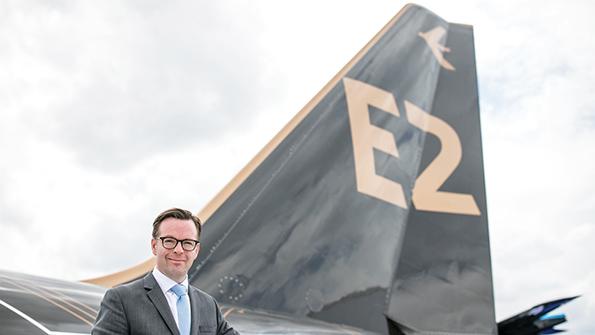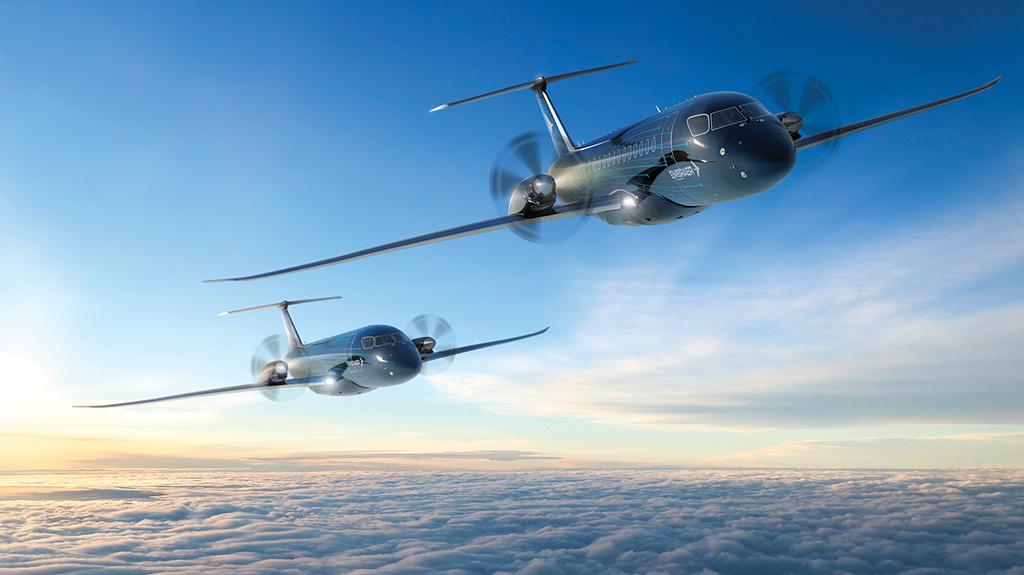
Almost exactly one year ago, Arjan Meijer, 48, was named the new president and CEO of Embraer Commercial Aviation. He could not have taken the job at a more difficult time: in the middle of the COVID-19 pandemic and just after Boeing had walked away from a deal to buy Embraer’s commercial aircraft business. Nonetheless, he is hopeful demand for orders will return soon as new projects are launched. Meijer sat down with Aviation Week’s Executive Editor for Commercial Aviation Jens Flottau to discuss the company’s technological innovations.
- Embraer Commercial Aviation CEO Arjan Meijer prepares turboprop launch
- Company expects strong rebound in regional aviation
- E1 replacement cycle to support demand for slow-selling E2
AW&ST: When is Embraer going to launch its own supersonic aircraft? Meijer [laughs]: Oh, we launched a lot of aircraft over the past several years, and we are talking about a new turboprop. So that is enough on our plate for now. We are going to put a lot of focus on how Embraer is going to contribute to sustainability. That is already challenging enough at the speed at which we fly today. And the faster you fly, the more challenging it becomes. I believe we are focusing on the right things.
Are you concerned that too much technology investment goes into niches like supersonic or electric vertical-takeoff-and-landing (eVTOL) aircraft and not enough into mainstream flying? No, I don’t see that. Everything that happens in the small segment is part of the learning for bigger aircraft. We are running Eve, which gives us a lot of insight on electrification. We are heading for the first electric flight of the Ipanema. We are really looking forward to our technology road map and how we can change our own products in commercial aviation. It will start slowly. Embraer is a company that wants to “underpromise” and “overdeliver.” There are a lot of things happening behind the scenes, but it is a bit too early to be more specific about them.
When are you going to share more about Embraer’s plans? Pretty soon—this year. What we are saying already is that we are looking at launching the turboprop in 2022. It will be traditional engine technology, but we will certainly also use the turboprop as a platform for future technologies. It is going to be a 70-90-seat turboprop, so quite sizable. Having a traditional engine now and then maybe a different kind of powerplant in the future, maybe based on sustainable aviation fuels (SAF) or different technologies, will further improve that platform.
The turboprop will have to be capable of using only SAF, right? Yes, that would be a first step. With that, it can be carbon neutral, but we are thinking beyond that to change the technology to something else. What that something else will be remains to be seen. At this moment, we are looking at all the options—electrification, hybrid or hydrogen. Then you could burn liquid hydrogen or use fuel cells, or a combination of these, with traditional power.
So you are saying you plan to design the aircraft in such a way that it can potentially go full-electric or full-hydrogen at some point in the future? Yes, except I believe fully electric [propulsion] is not going to happen [for that aircraft size]—unless you use a hydrogen tank and convert that into electric energy through fuel cells.
Would the more accurate description be that you want to be able to completely change the propulsion system when the time is ripe? Correct. And maybe if we do a [conventional] 70-seater that does not stay a 70-seater because we use part of the fuselage for a hydrogen tank in the future. It is too soon to tell. The 70- and the 90-seaters have a fuselage that is also extendable.
Isn’t that approach problematic for the engine OEM business model because it means whoever builds the engine will almost by definition sell fewer of them? Potentially, but it’s not like if the second option becomes available the first automatically stops. We could continue to offer alternative versions. [The approach] also offers opportunities for the engine OEMs to work with us on future applications. You can see that as a threat but also as an opportunity. We are talking to the different powerplant providers currently. We have not made a decision. One thing to keep in mind for the turboprop is that there is also emerging interest from the U.S. The 70-seater could be used as a three-class 50-seater, so it could be used to replace aging 50-seaters.

The other part of your road map is what you could do in the segment up to 50 seats, right? Talking about long-term targets is the easy work, but how to get there is what we are looking at here. Getting the turboprop to market with existing technology is the first priority. In parallel, we think about how we can make it more environmentally friendly beyond that, with new technology. The road map will run to at least 2040. We see the urgency, but it will take time.
The eVTOL will always use a multiple of the energy that an electric car would use on the same route. For longer stage lengths, electric cars or trains may not be an option. Does there have to be a policy debate about the use of green energy? Historically, I don’t think that has happened. It has always been a matter of supply and demand. If you compare an eVTOL flight from the center of Sao Paulo to the airport with a taxi trip, you save 1.5 hr. That is a trade-off that people will make. The energy question is more about cost. Green energy is going to be more expensive. How we pay for it collectively is the question we need to ask. We should simply focus on how we can solve the global CO2 problem with the money that we have and not discuss the details of different modes of transport.
You have been CEO of Embraer Commercial since early 2020, but because of the pandemic you still have not been back to Sao Jose dos Campos or Sao Paulo, right? True. We have a strong policy of protecting our people, so people are working from home. If I went to Brazil, I’d be working from the local hotel behind my laptop talking to the same people as I do from here. I still would not get the physical meeting. Hopefully, that is going to be less of an issue in the second half of this year. But it is crazy. If you had asked me in 2019 whether I could be CEO of this organization from my home in Amsterdam, I would have said “no.” Luckily, [information technology] is advanced enough to have virtual face-to-face meetings. They are a good surrogate for physical meetings. Imagine [if] we would have had this crisis 15 years ago—it would have been all telephone calls or text messages.
Some of Embraer’s big commercial aviation functions, like engineering and operations in Brazil, are under the corporate structure rather than in your organization. Is that problematic? No, I think there is complete alignment. [Embraer CEO] Francisco [Gomes Neto] is driving the one-Embraer approach very hard. The programs team in Sao Jose dos Campos works with operations on a day-to-day basis. The benefits of a single engineering organization—that works across the divisions and gets all the efficiencies and spreads the knowledge to all the businesses—are much bigger than the challenge of separate reporting lines. Francisco has done a lot of work with the team to reintegrate commercial aviation, put the right people in place, establish the right culture and follow a strategy that we will accept as a leadership team.
In 2020, the decline was worse for regionals than for mainline aircraft. Why was that the case? At Embraer, we are normally at a level of 90-100 aircraft deliveries per year. We delivered 44 in 2020. Maybe Airbus did better last year, but in the worst of the worst years we still had 44 aircraft out the door. We did not have any cancellations. We helped the customers and they helped us, so we weathered last year quite well. Hopefully, the numbers this year will be somewhat better. I’m not giving guidance, but I hope that we will be slightly better than last year. We have a five-year plan that should bring us back to precrisis levels.
Even before the crisis, demand across the industry had already become weaker. Were airlines simply taking a pause with enough capacity in the market? The 175-E1 has been going steady. We launched the E2 rather early in the program in 2013, when the E-Jets were less than 10 years old. Some operators were still considering the E1s as fairly new and were not looking at replacements. The whole Boeing situation created some discomfort with customers about what was going to happen. That did not help. Fast-forward to 2021: We do see demand from airlines wanting to replace E1s. There have never been the kind of aircraft in the 100-150-seat segment that we have today. They have historically always been the disadvantaged siblings of the narrowbodies. Now we have two crossover types that can do the job very competently. At these economics, given the noise levels and the sustainability benefits, we will see a pickup in demand for the E2 in the next couple of years.
You just confirmed a large order for 30 195-E2s from an undisclosed customer. Yes, and we will hopefully disclose it within the next two months.
Was that the beginning of more orders or just a special case? I think it will be the beginning of more. Managements truly understand that the regional sector is something to look at. I strongly believe that we will see more coming soon.
Some of your customers, including AerCap CEO Aengus Kelly, said Embraer Commercial could not compete on a standalone basis before the Boeing deal collapsed. I think it is completely the other way around. Let’s not forget that the world has turned 180 deg. since the Boeing deal collapsed. At the time, yes, we were surprised and disappointed. But now, with the Embraer portfolio—and how executive is picking up, how defense is doing and how commercial will bounce back after the crisis—we see a lot of appreciation from customers. And airlines are going to be more risk averse. After the crisis, trip costs have become important. If there is an aircraft that has 25-30% lower trip costs and seat-mile costs are still comparable, that is something people should look at.
If the recovery is as fast as some people think, then airlines may go back to old habits quickly and fly Airbus A320s. “If.” But if you look at the latest International Air Transport Association forecast, there is an emerging gap between passenger numbers and revenue seat kilometers, so there could be a focus on smaller routes and more regional flying.
Do you have to accept that China will not be the big regional market that everyone hoped it will become because China will protect its own industry? I am not at that point yet. We are still working on getting the E2 certified there. China does not have a product in this segment. The C919 is a narrowbody. The ARJ21 is more like an Embraer 175. In between, the crossover segment could play a huge role to connect secondary and tertiary airports.




Comments